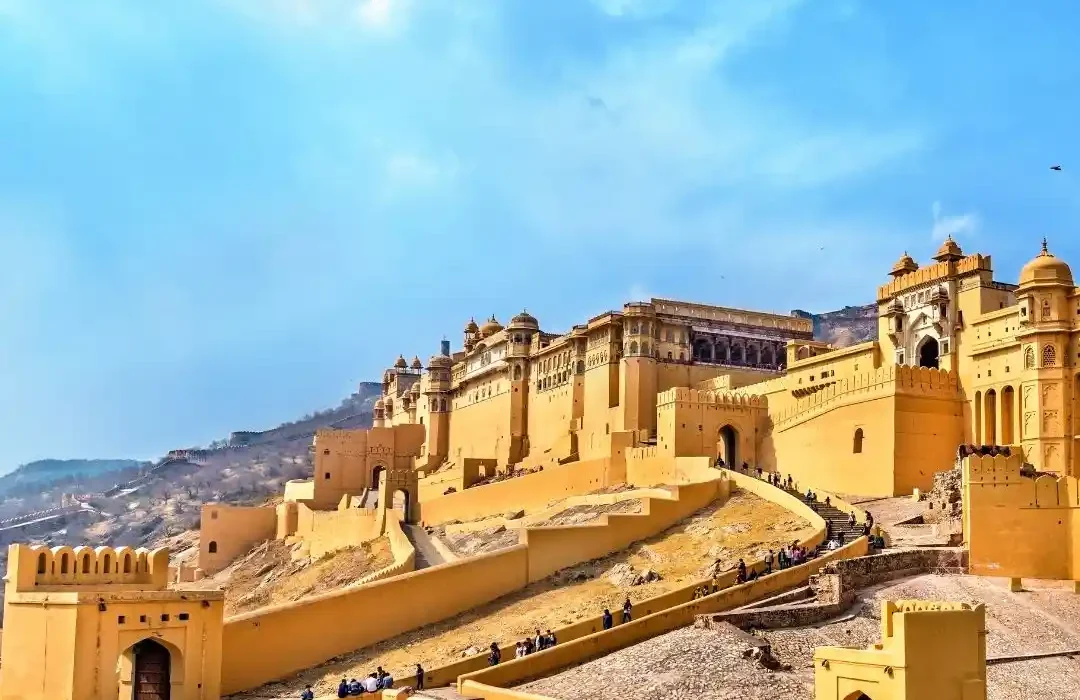Amer Fort: A Majestic Gem of Jaipur, Rajasthan
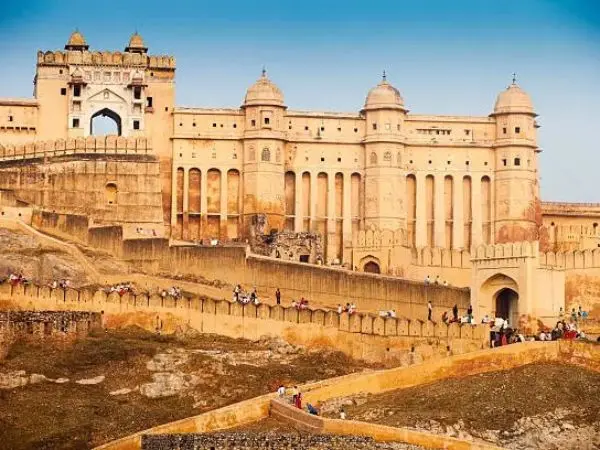
The forts of Rajasthan are a unique feature of the state, and every major fort has its own characteristic structure, intensity of design and beauty. The Amer Fort (or Amber Fort) may be described as the jewel in the crown of Jaipur. It blends together Rajput and Mughal architectural styles; and, with its beautiful courtyards, fine carvings, halls of audience, residential palaces and Hall of Mirrors ( Sheesh Mahal), it offers a visual history of Jaipur’s royal past.
This impressive structure, in its equally impressive hilltop location surrounded by hills, came into existence as the Kingdom of Amber, when the first lands to be seized from the Meena tribes who controlled the region were the hills surrounding the small town of Amber. The construction of the Fort in its present form was begun in 1592 by Maharajah Man Singh I, King of Amber at the time, who was also a general in the Mughal army. The expansion and elaboration of the Fort continued as subsequent Maharajas added their own touches, and for a couple of hundred years more Amer Fort served as a royal residence. This was much before the founding of the ‘Pink City’ of Jaipur. It was only after the Kacchawa clan of Rajputs had consolidated their dominance over the Meenas, and Rajput authority over the region surrounding Amber was established, that the walled city of Jaipur came to be founded as a planned city by Maharajah Jai Singh I, as the new capital, showpiece of the now prosperous kingdom of Jaipur, and a magnet for the flourishing of science, the creative arts and trade. Today, the Amber Fort continues to be a pre-eminent historical landmark, and a must-see destination for tourists, captivating visitors with it’s imposing presence, grand halls and elaborate mirror work as it towers over the medieval Pink City and the modern city of Jaipur beyond, and offers stunning views of both spreading out below. Amer Fort is situated approximately 11 kilometers from downtown Jaipur city and can be reached by taxi or city vehicle. The distance from the Hawa Mahal to the Amer Fort is about 9 kilometers.
Where is Amber Fort Located?
Amer fort Address:
- Location: Amer, Jaipur, Rajasthan 302028, India. Click here for Amer fort Google Map Location.
Amer Fort Architecture: A Marvel of Design
The red sandstone and marble Fort comprises four quarters:
- Ganesh Pol: The entrance gate of the Fort with stunning murals depicting Lord Ganesh.
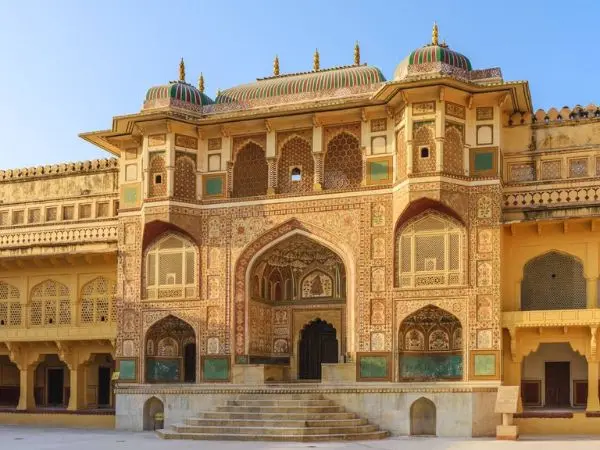
- Diwan-i-Aam (Hall of Public Audience): A very large hall designed for the Maharaja to address the public.
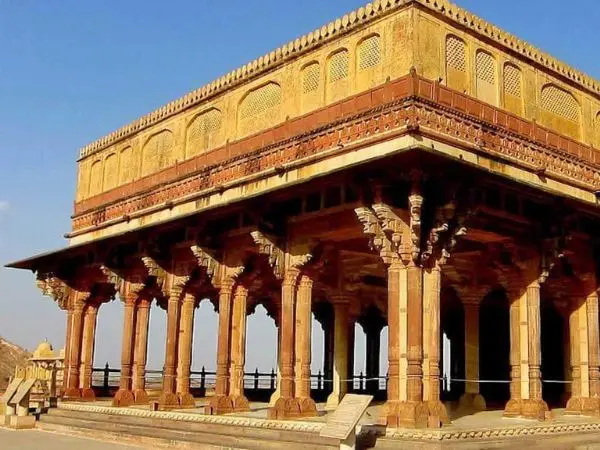
- Sheesh Mahal (Hall of Mirrors): This beautiful Hall is lined with hundreds and thousands of mirrors; just one candle can light the room up.
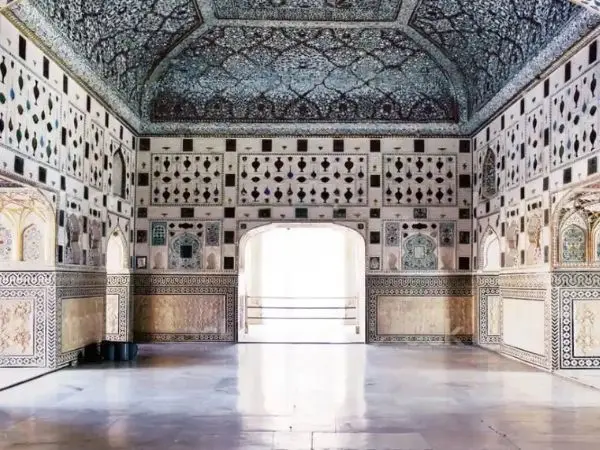
- Sukh Niwas (Hall of Pleasure): A cool room during the hot summer months, with an ingenious water channeling system.
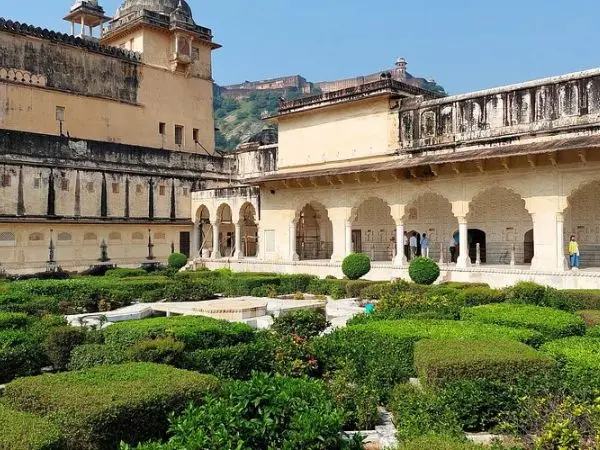
- Hammam (Turkish Bath): A hammam (Arabic for “bath”) north of the Diwan-i-Khas served the ruler and royal family, with separate hot/cold tubs, changing and massage rooms, toilets, and a hearth to heat water. It’s also directly accessible from the Sheesh Mahal.
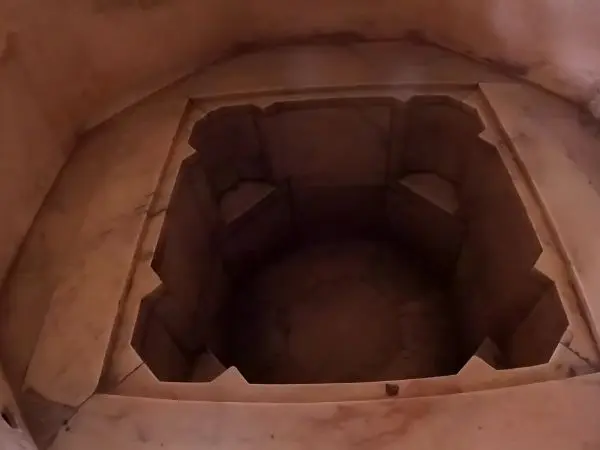
- Suraj Pol (Sun Gate): Suraj Pol (Sun Gate) was the exclusive, east-facing entrance to Amber Palace, named for its alignment with the sunrise. Royal processions and dignitaries entered here, and the palace guards were stationed at the gate.
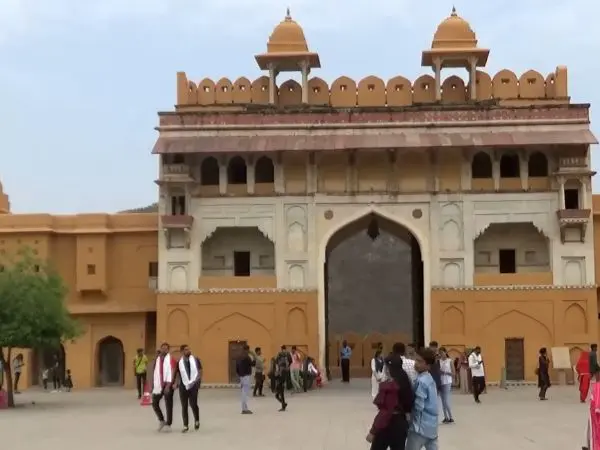
- Singh Pol (Lion Gate): Singh Pol—the main gateway to the palace—was built by Sawai Jai Singh (1699–1743), named for the lion symbolizing strength, and adorned with exterior frescoes. Its angled passage enhanced security so guards posted above could strike intruders from the rear.
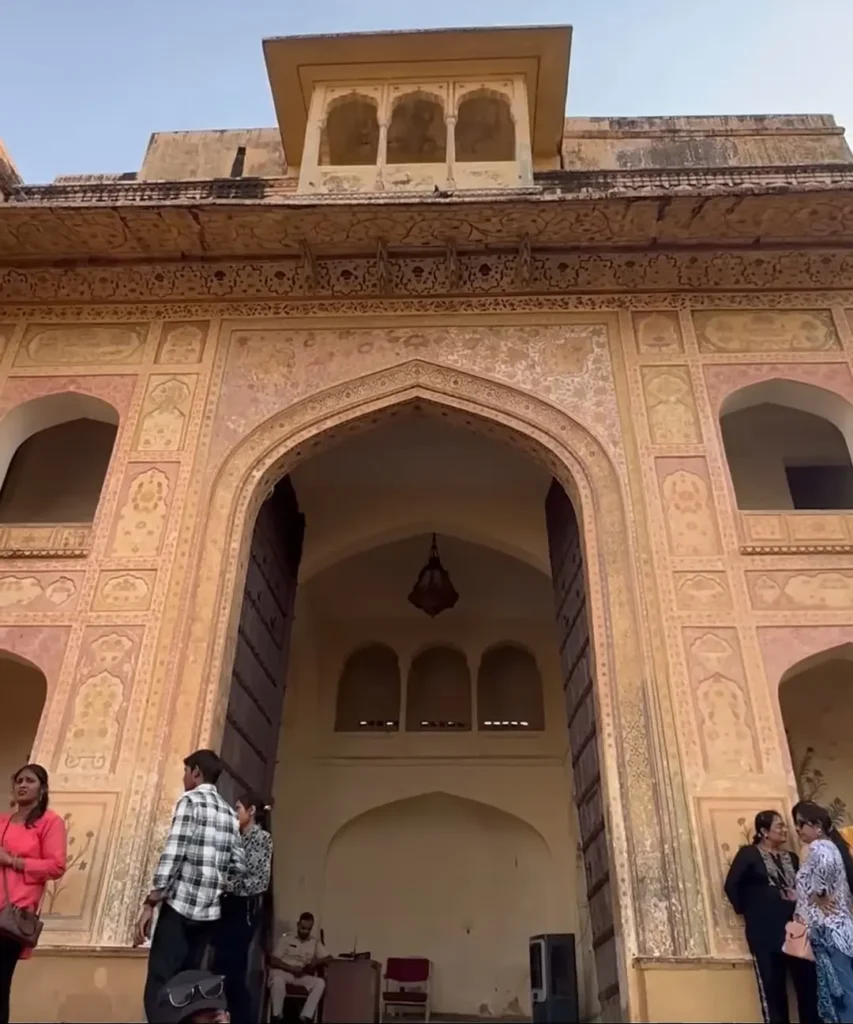
- Bhojanshala (Dining Hall): The Bhojanshala was the royal dining hall for the ruler, family, and guests. To invoke blessings before meals, Sawai Jai Singh (1699–1743) adorned its walls with 17th–18th-century paintings of family deities and pilgrimage sites, including Lord Vishnu.
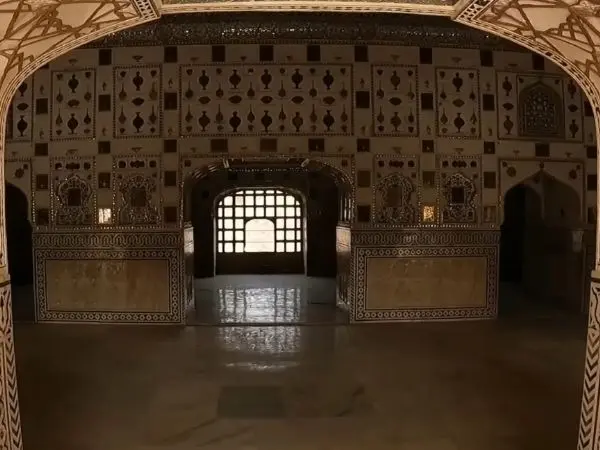
- Palace of Raja Man Singh: Completed in 1599 under Raja Man Singh after ~25 years, this original main palace centers on a square with a baradari pavilion. Rooms across the lower/upper floors—and the two rooftop chambers—are richly adorned with frescoes (even beneath sunshades) and colored tiles.
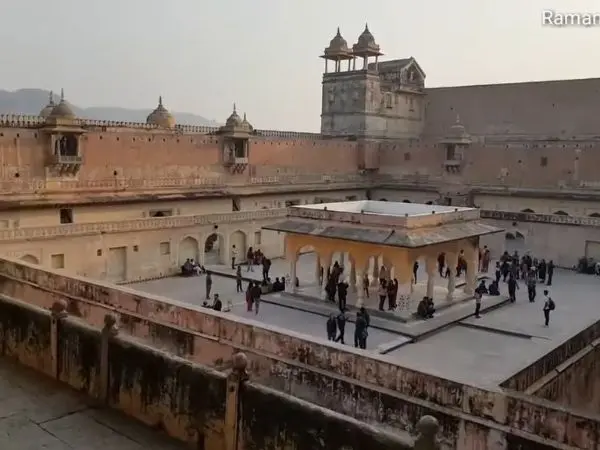
- Rang Mahal (Palace of Colours): Rang Mahal (“Palace of Colours”) sits at Amber Palace’s southern end above the tunnel to Jaigarh Fort, featuring arched verandas and vase-shaped pillars in Indo-Islamic style, with ceilings, walls, and columns adorned in araish and Rajasthani aala-geela frescoes (akin to Italy’s fresco buono). From here, the views of Jaigarh and Amber’s eastern and western hills are spectacular.
- Chand Pol (Moon Gate): Chand Pol (Moon Gate) was the main entrance for commoners; its upper floor, the Naubatkhana, housed kettle drums and other instruments. Ceremonial “naubat” music—observed with strict protocol and silence—has a tradition believed to date back to Alexander the Great.
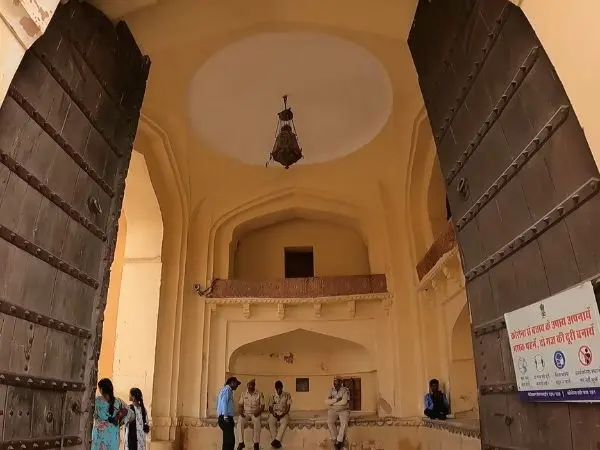
- Diwan-I-Khas: Diwan-i-Aam, modeled on Mughal halls, was the public court where the Raja met subjects and held festivals; built by Mirza Raja Man Singh (1589–1614) in red sandstone and marble, it fuses Mughal-Rajput decor—carved elephant heads and vines—with a roof on paired red-sandstone outer columns and cream-marble inner columns. Later, Maharaja Sawai Ram Singh II (1835–1880) turned the rear into a billiard room, and to the south the 27 colonnaded kachehris (Toshakhana) housed the Amber state secretariat.
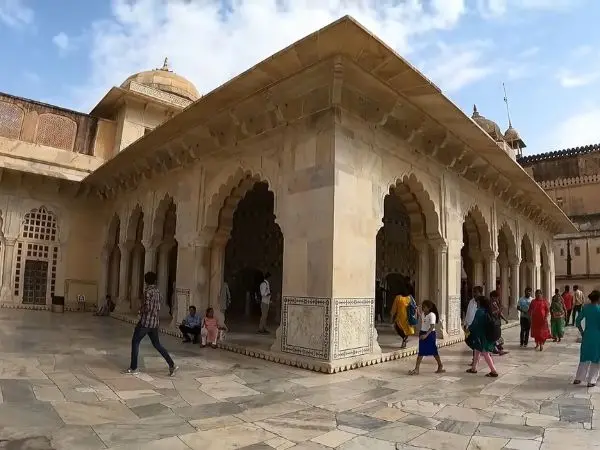
- Water Storage Tank of Man Singh’s Palace: Man Singh’s Palace had three underground water storage tanks beneath Jaleb Chowk, Diwan-i-Aam, and the palace itself, designed to collect and store rainwater efficiently while minimizing evaporation and keeping it potable for longer periods.
- Kesar Kyari (Saffron Flowerbeds): Amber features beautifully landscaped gardens, with Kesar Kyari being a highlight — a three-tiered, star-shaped Persian-style garden on Maota Lake’s island, once adorned with rare saffron flowers and soothing water features.
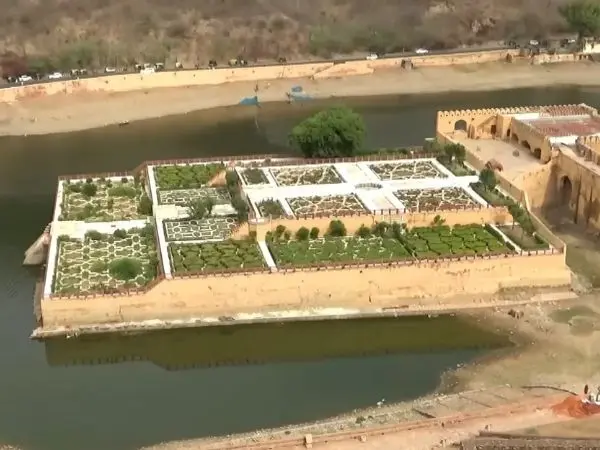
- Jaleb Chowk: Jaleb Chowk, meaning “gathering place for soldiers,” is one of Amber Palace’s four courtyards where the Raja’s bodyguards once paraded and were inspected; its lower floors housed stables, while the upper floors accommodated royal guards.
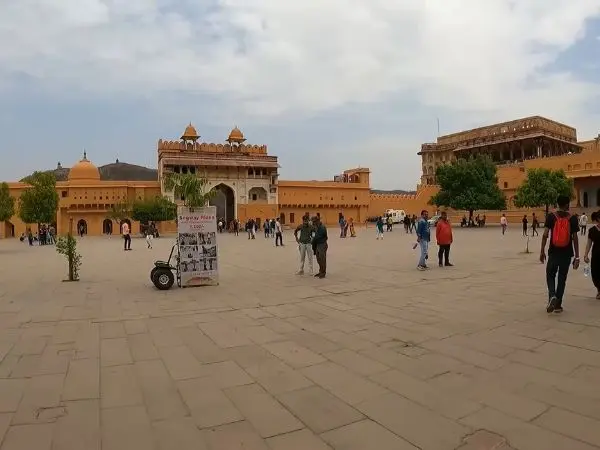
- Water Storage Tank of Diwan-i-Aam: The Diwan-i-Aam features one of three underground rainwater storage tanks in Amber Palace, designed to keep water potable for longer periods while minimizing evaporation and ensuring a steady daily supply.
- Rasoda-The Royal Kitchen: The Rasoda, or Royal Kitchen, had two sections—one beside the Bhojanshala for the ruler and guests, and another near Tripolia Gate for staff—where skilled cooks prepared elaborate meat and vegetable dishes using multi-mouthed ovens.
- Sukh Mandir (Diwan-i-Khas): Sukh Mandir, or Diwan-i-Khas, served as the royal family’s summer retreat, featuring Mughal-style plastered walls, a marble cascade for natural cooling, and teakwood doors inlaid with ivory overlooking the palace gardens.
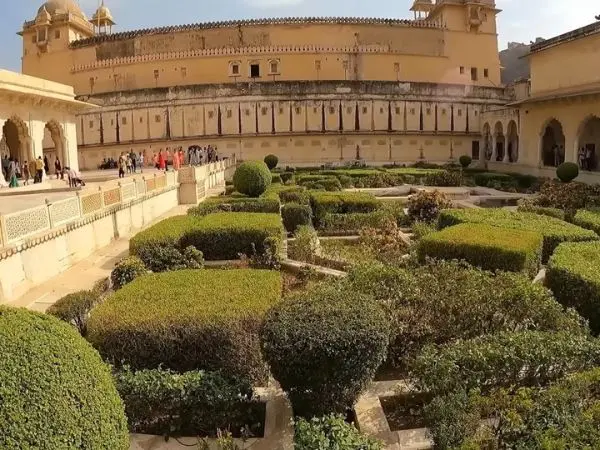
- Tripolia (Three Gates) Gateway: The Tripolia Gate, meaning “Three Gates,” served as the main western entrance to the palace, opening in three directions—to Jaleb Chowk, Man Singh Palace, and Zenani Deorhi—symbolizing the strategic layout of royal architecture.
Amer Fort Timings and Entry Fees
- Amer Fort Opening Time: 8:00 AM
- Amer Fort Closing Time: 6:00 PM
- Evening Light and Sound Show Time: 6:00 PM to 8:30 PM
- Amber Fort General Ticket Price:
- Indian Adult: ₹100
- Indian Student: ₹20, requires a valid ID card.
- Foreigner Adult: ₹500
- Foreign Students: Around ₹150, requires a valid ID card.
Must-See Attractions at Amer Fort
- Amber Palace :
The Amber Palace, is one of the most popular areas of the fort, and has beautiful courtyards and a spectacular design. There are many significant rooms including the Diwan-i-Khas, Sheesh Mahal, and Jaleb Chowk.
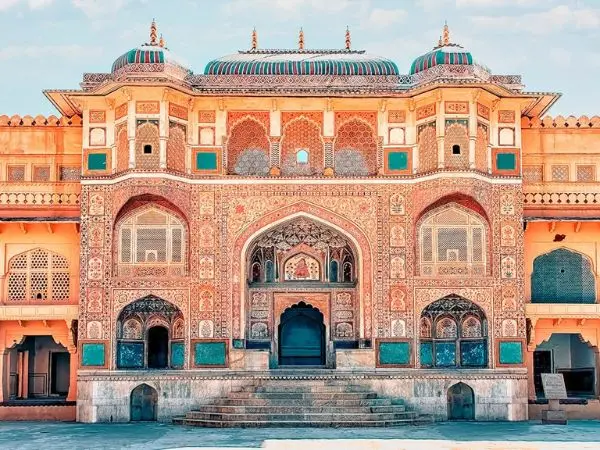
- Amber Fort Elephant Ride :
An elephant ride is one of the most recognized experiences for visitors to the Amber Fort. It was once the mode of transport for royals to enter the Fort; today, many tourists try and simulate that feeling of grandeur, riding elephants all the way up the hill to the entrance. The cost of an elephant ride could be variable, but starts at approximately ₹500-1000 (Subject to change).
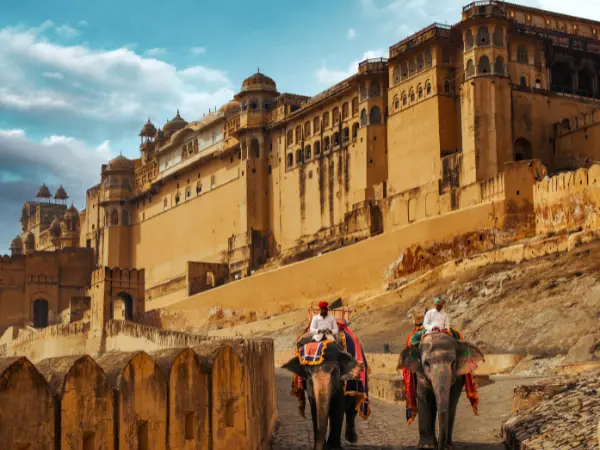
- Amber Fort Light and Sound Show :
The Light and Sound Show at the Amer Fort recounts the fort’s history. The historical narration is accompanied by a spectacular show of lights and sound. The Show is an authentic way to bring the history of Amber Fort (Jaipur) to life. Tickets to the Amber Fort Light and Sound Show can be purchased at the fort; show timings are between 6:00 PM to 8:30 PM.
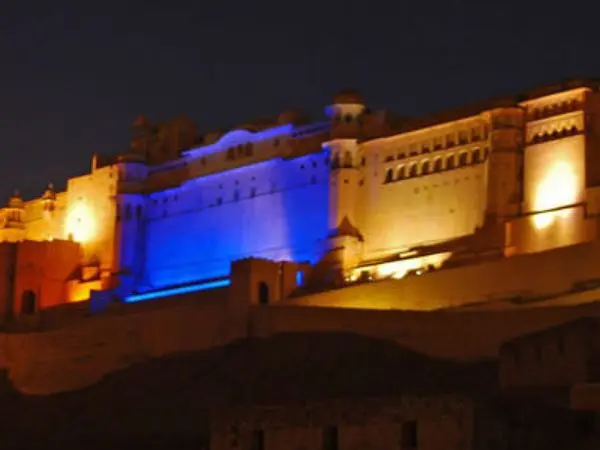
Amer Fort: Fascinating Facts
- Amber Fort to its sister-fort Nahargarh (Distance): About 6 kilometers.
- Amer Fort (Jaipur) at Night: Amer Fort is beautifully illuminated at night.
- Distance from Jaipur Railway Station to Amber Fort: Around 12 kilometers.
Amer Fort Tour: What to Expect
At Amer Fort, the best option to understand the history and architecture is to join a guided tour–you may visit on your own, but you will know much more about its history and significance by joining a guided tour.
Amer Fort Ticket Online Booking and Additional Tips
- To steer clear of extended lines, you’d be smart to book your Amer Fort ticket online Click Here: https://obms-tourist.rajasthan.gov.in/
- If you’re looking to take the elephant ride, do so well in advance, since this is very popular with tourists
- The fort is particularly beautiful at sunset, and offers beautiful views of Jaipur and the surrounding hills.
Conclusion
With its rich history, elaborate architecture and panoramic views, Amer Fort remains one of the best attractions in Jaipur, Rajasthan. From the Sheesh Mahal to the elephant ride, you will not be at a loss for things to see and things to do while in Amer Fort. Be sure to plan your time beforehand, buy your tickets in advance, and prepare to be blown away by the magnificence and beauty of Amer Fort.

